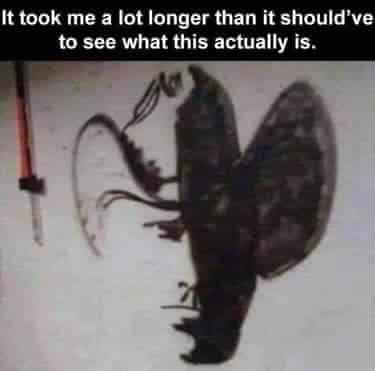It took me a lot longer than it should ve to see what this actually is
The image shows what initially appears to be a large, dark silhouette of a butterfly on a light-colored wall. The shadowy figure has wings outspread, and the shape seems detailed enough to suggest the veins and scales commonly found on a butterfly's wings. The left side of the image includes a line that could be misconstrued as part of an antenna sticking above the silhouette.
The caption above this image reads "It took me a lot longer than it should've to see what this actually is," which already hints at a kind of visual trickery at play. This caption sets the stage for the viewer's expectations, prompting a closer examination of the image in search of an alternate explanation for what they're seeing.
Upon closer scrutiny, the viewer can discern that the "butterfly" is not actually a butterfly at all, but a clever visual illusion. This realization is the crux of the humor; the image is a playful deception that toys with our pattern recognition instincts. Humans are wired to recognize familiar shapes in vague or abstract patterns—a psychological phenomenon known as pareidolia.
The humor arises from the deception itself and the resultant 'aha' moment when the viewer realizes the true nature of the image. The chuckle comes from the juxtaposition of the initial mistaken identity and the latter understanding, creating a benign form of cognitive dissonance. It’s a visual pun of sorts, a trick that reveals our minds can be easily fooled, and there's humor in the shared experience of being duped and then enlightened.
The image, once deciphered, reveals that the supposed butterfly is actually created by two distinct objects: a hanging black object, probably footwear, which forms the central body and part of the wing, and an open jacket or piece of clothing that creates the other part of the wing. These discernments lead to the realization that it’s just everyday items casting a shadow that coincidentally looks like a butterfly, providing the viewer with the joke's payoff.
Why people find such images funny is rooted in the joy of surprise and the delight in cognitive challenges. There is a playful element to such images—the way they tease the brain's pattern recognition systems—and the eventual realization provides a small endorphin rush, akin to solving a puzzle. This type of image caters to the universal human appetite for whimsy and the satisfaction of 'getting' a joke. It took me a lot longer than it should ve to see what this actually is
